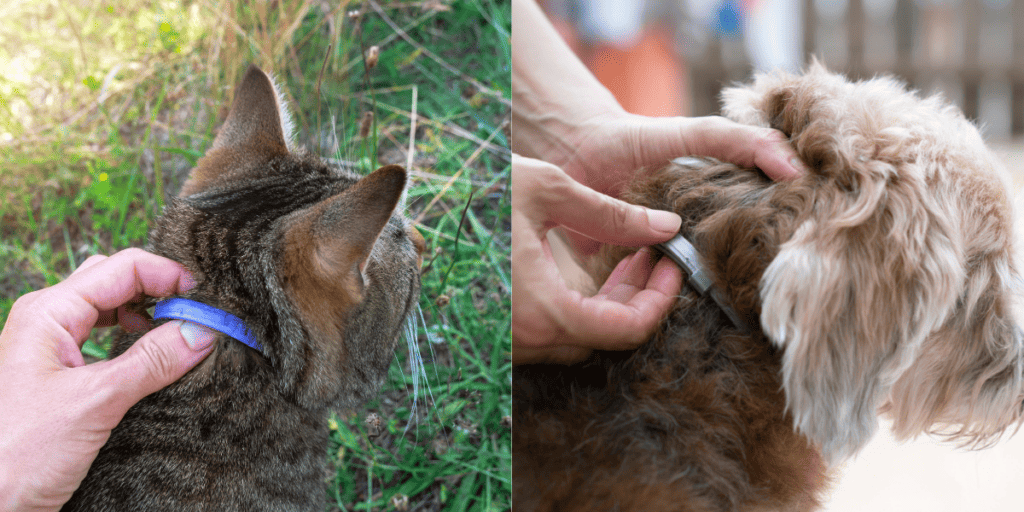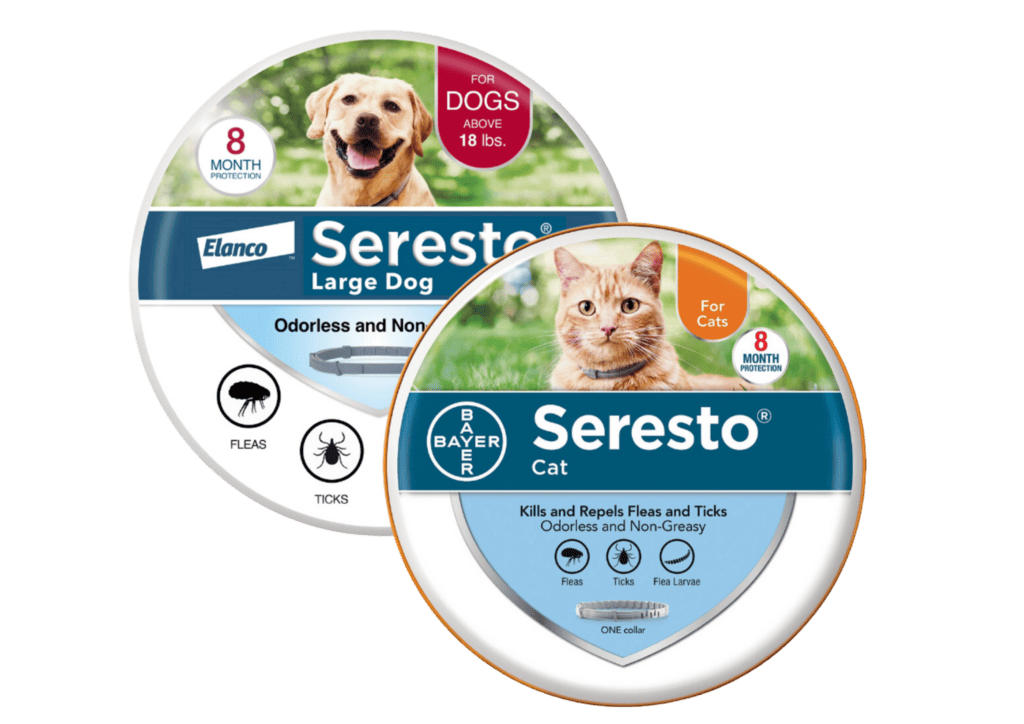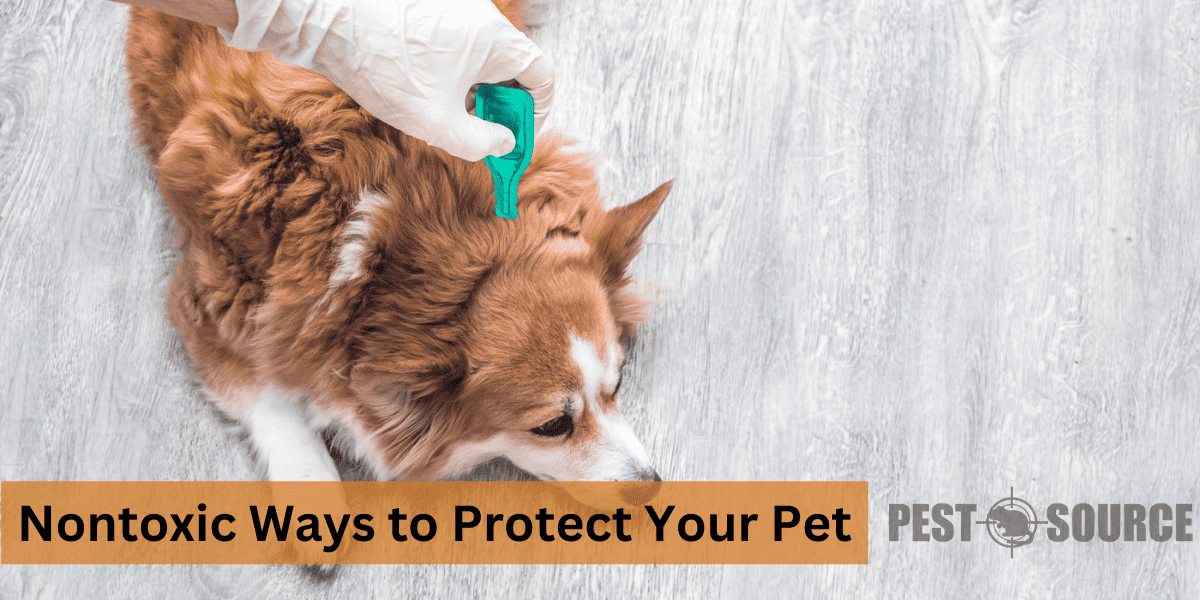As a responsible pet owner, it’s essential to protect your furry friends from troublesome fleas and ticks. While many pest treatments are available, some can potentially harm your pets due to their chemical contents and side effects.
This comprehensive guide will explore the importance of safe flea and tick prevention, delve into the safest flea and tick treatments, discuss non-toxic alternatives, and offer the best prevention practices. By understanding the implications of conventional treatments and making well-informed decisions with your veterinarian, you can safeguard the health and happiness of your pets.
POINTS
- Flea and tick prevention is crucial for pets due to the potential health problems and diseases these parasites can cause, making it essential for pet owners to remain diligent about preventing infestations.
- Some conventional flea and tick treatments contain harmful chemicals that can cause side effects or toxicity in pets. It’s important to consult with a veterinarian to find the safest treatments for your pet’s specific needs.
- Flea and tick prevention products, such as collars and pills, offer varying degrees of safety and effectiveness. Make sure to discuss available options with your veterinarian to determine which product should be used for your pet.
- Non-toxic alternatives for flea and tick prevention, such as natural methods and organic or holistic strategies, could be a safer option for some pets. Consult with your veterinarian to explore these alternatives and find the most suitable method for your furry friend.
- Ensuring proper flea and tick prevention involves following best practices, such as regularly administering a veterinarian-recommended preventative, grooming your pet, and keeping your home and yard clean. Regular consultations with your veterinarian will keep you updated on the latest advancements in flea and tick prevention.
The Importance of Safe Flea and Tick Prevention for Pets
Why is flea and tick prevention important for pets?
Flea and tick prevention is crucial for pets, as these parasites can cause significant discomfort and health problems, such as skin irritation, allergic reactions, and anemia. Additionally, both fleas and ticks can transmit diseases to pets, increasing the potential for severe medical conditions. Therefore, it is essential for pet owners to stay diligent about preventing these pests from infesting their beloved animals.
What are the potential dangers associated with flea and tick treatments?
While many flea and tick treatments are effective, some may contain harmful chemicals that can be toxic to pets. These treatments can cause side effects such as skin irritation, vomiting, diarrhea, seizures, and even death in extreme cases. In addition, some conventional treatments might not be suitable for all breeds, ages, or sizes of pets, increasing the risks associated with their use. Therefore, pet owners should be aware of safer, nontoxic alternatives for flea and tick prevention.
Understanding Fleas and Ticks: What Are They and How Do They Affect Pets?
What are fleas and ticks?

Fleas and ticks are external parasites that feed on the blood of warm-blooded hosts, like dogs, cats, and humans. To better understand the distinct challenges and risks posed by fleas and ticks to pets, it’s helpful to compare them side-by-side.
| Feature | Fleas | Ticks |
|---|---|---|
| Size | Tiny (1.5-3.3 mm long) | Larger than fleas, vary in size |
| Appearance | Small, dark, wingless insects | Small, dark, spider-like arachnids |
| Behavior | Jump to move and reach hosts | Crawl until they find a host to attach |
| Reproduction | Lay eggs on host or in nearby environment, leading to rapid infestation | Lay eggs in the environment, slower reproduction rate |
| Diseases Transmitted | Can transmit tapeworms and cause allergic reactions | Carry Lyme disease, Rocky Mountain spotted fever, and other serious diseases |
| Health Impact on Pets | Dermatitis, allergic reactions, potential anemia from heavy infestations | Disease transmission, localized infection, potential for severe health complications |
| Prevention Difficulty | High due to rapid reproduction and ability to jump | Moderate, with emphasis on regular checks and environmental management |
Understanding these differences highlights the importance of targeted prevention strategies tailored to the specific threats posed by each parasite.
What are the effects of fleas and ticks on dogs and cats?
Fleas can cause excessive itching, skin irritation, hair loss, and scabs in pets. They can also transmit tapeworms if ingested by the pet during grooming. Severe flea infestations can lead to anemia, especially in small or young animals.
Ticks can transmit various diseases and cause localized redness, swelling, and infection at the bite site. They may also lead to lethargy, joint pain, and fever if the disease-causing bacteria are present in their saliva and transmitted to the pet.
How can ticks and fleas potentially harm your pet?
Ticks and fleas can inflict considerable harm on pets by causing physical discomfort, severe skin reactions, and potentially transmitting dangerous diseases. These parasites can also weaken the pet’s immune system and overall health, possibly opening the door for secondary infections and complications. In the worst cases, untreated tick-borne diseases can lead to organ damage, neurological problems, or death.
What are the Potential Risks of Conventional Flea and Tick Treatments?
What are the reported side effects of flea and tick medicine in dogs and cats?
Conventional flea and tick medicines contain chemicals that may cause side effects in some pets, such as:
- Skin irritation or hair loss at the treatment site
- Gastrointestinal issues like vomiting or diarrhea
- Lethargy, depression, or changes in behavior
- Neurological symptoms such as seizures or tremors
These side effects may be mild or severe, depending on the individual pet and the specific treatment used. If you notice any adverse reactions after administering flea or tick treatments, contact your veterinarian immediately.
What flea and tick medicines have been linked to seizures in pets?
Some flea and tick medications containing isoxazoline (a class of insecticides) like fluralaner, afoxolaner, and sarolaner have been linked to seizures in pets. The FDA has released a warning about this potential risk and advises pet owners to discuss the safety and appropriateness of these products with their veterinarians.
Are all flea and tick treatments equally safe for different breeds and sizes of pets?
No, not all flea and tick treatments are equally safe for all breeds and sizes of pets. Some treatments may be toxic or have a higher risk of side effects in certain breeds, ages, or sizes of pets. Always consult with your veterinarian before starting any treatment and closely follow the recommended dosage and application instructions.
Are topical flea treatments safer than oral treatments?

The safety of flea treatments largely depends on the individual pet, the specific product, and how it’s used. Some animals may tolerate topical treatments better, while others might have fewer side effects with oral medications. It’s essential to discuss all available treatment options with your veterinarian and carefully follow their recommendations for your pet’s specific needs.
What is the Safety Profile of Flea and Tick Collars for Pets?

Are flea and tick collars safe for pets?
Flea and tick collars can be a safe and effective means of preventing infestations in pets. However, not all collars are created equal, and some may contain chemicals that could be harmful to pets if ingested or improperly used. To ensure the safest flea and tick collar for your pet, discuss available options with your veterinarian and always follow the manufacturer’s instructions.
What is the difference between dog and cat flea collars in terms of safety?
Dog and cat flea collars are formulated with different concentrations and types of active ingredients based on the specific needs and sensitivities of each species. Using a dog collar on a cat or vice versa can result in severe side effects or toxicity. It is essential to buy and use flea and tick collars specifically designed for your pet’s species to ensure their safety.
What are the safest flea and tick collars for dogs and cats?
Some flea and tick collars have been praised for their safety and effectiveness, such as Seresto collars, which use imidacloprid and flumethrin as active ingredients. However, some pets may still experience adverse reactions, especially if sensitive to any of the ingredients. Always consult with your veterinarian about the safest and most appropriate flea and tick collar for your pet.

How Effective and Safe are Flea and Tick Pills for Pets?
What is the safety and efficacy profile of flea and tick pills for dogs?
Flea and tick pills have become a popular choice for many pet owners due to their ease of use and effectiveness in controlling and preventing infestations. Some oral medications, such as Nexgard (afoxolaner) and Bravecto (fluralaner), have proven to be highly effective in killing fleas and ticks. However, as mentioned earlier, there have been reports of neurological side effects, particularly regarding isoxazoline-based medications. Consult with your veterinarian to determine the safest and most effective oral flea and tick prevention for your dog.

How safe are flea and tick pills for cats?
Flea and tick pills for cats have similar safety profiles to those for dogs. Products like Comfortis (spinosad) and Bravecto for Cats (fluralaner) have demonstrated high efficacy in controlling and preventing flea infestations in cats. However, as with canines, certain pills containing isoxazolines have been linked to seizures, making it crucial to discuss these matters with your veterinarian.

What are the safest flea and tick pills for dogs and cats?
The safest flea and tick pills for dogs and cats will largely depend on each pet’s individual health, age, breed, and potential sensitivities to specific ingredients. It’s crucial to consult your veterinarian, who will help you determine the safest and most appropriate oral flea and tick prevention strategy for your furry friend.
What are the Safest Flea and Tick Treatments for Dogs and Cats?
What is the safest flea treatment for dogs?
A safe flea treatment for dogs should avoid harsh chemicals that may cause adverse reactions. Topical treatments like Advantage II (imidacloprid) and Frontline Plus (fipronil and (S)-methoprene) offer a good balance of safety and effectiveness for many dogs. However, the best approach to finding the safest flea treatment for your dog is to consult with your veterinarian, who can guide you based on your dog’s unique needs.

What is the safest tick prevention for dogs?
Topical treatments combining an effective tick-repelling agent with protective ingredients like Frontline Plus or K9 Advantix II (imidacloprid, permethrin, and pyriproxyfen) can be safe and effective options for tick prevention. Again, consult with your veterinarian to help determine the safest and most appropriate tick prevention product for your dog.
What is the safest flea treatment for cats?
For cats, safe and effective flea treatments include Advantage II, Frontline Plus, and Revolution (selamectin), which may prevent not only fleas but also heartworms and some other parasites. As with dogs, consult your veterinarian to ensure the selected flea treatment is safe and well-suited for your cat’s unique requirements.
What is the safest flea and tick prevention for dogs and cats in recent years?
The safest flea and tick prevention for dogs and cats continues to evolve as pet-specific research gives rise to new products and formulations. In recent years, Seresto collars and topical treatments like Advantage II and Frontline Plus have been popular for their safety profile. However, always consult with your veterinarian for the latest advancements and guidance on the safest flea and tick preventatives for your pet.
Are There Safe Flea and Tick Treatments for Puppies and kittens?
What is the safest flea treatment for puppies?
Puppies require special care when it comes to flea treatments due to their sensitive skin and developing immune systems. For puppies older than eight weeks, products such as Advantage II for Dogs or Frontline Plus may be safe options. However, always consult with your veterinarian before starting any treatment and follow their guidance on appropriate dosages and product selection for your puppy.
Is there a safe flea treatment for kittens?
Similar to puppies, kittens also have delicate skin and immune systems requiring extra care. For kittens older than eight weeks, Advantage II for Cats and Frontline Plus have been shown to be safe and effective options. Again, always consult with your veterinarian before administering any flea treatment to your kitten and adhere to their dosing recommendations.
What precautions should be taken when treating puppies and kittens for fleas and ticks?
When treating puppies and kittens, pet owners should take the following precautions:
- Consult with your veterinarian before beginning any flea or tick treatment.
- Use products specifically designed for use in puppies or kittens, and adhere to the recommended dosages.
- Monitor your pet for adverse reactions or side effects and contact your veterinarian immediately if any occur.
- Keep treated pets separate from other animals until the product has dried or been absorbed to prevent ingestion by grooming.
What are the Non-Toxic Alternatives for Flea and Tick Prevention in Pets?
What are the natural flea and tick prevention methods for dogs?

Several natural methods can help prevent flea and tick infestations in dogs, including:
- Food-grade diatomaceous earth: Sprinkle it on your pet’s coat and bedding to help kill and repel fleas and ticks.
- Herbal flea and tick collars: Some collars use essential oils like cedar, lavender, or lemongrass to naturally repel pests.
- Natural sprays: Homemade sprays using natural ingredients like apple cider vinegar, lemon, or lavender oil can help deter fleas and ticks.
While these methods can be less harmful, they may be less effective than conventional treatments. Consult with your veterinarian about the most suitable non-toxic alternatives for your specific dog.
What are the non-toxic flea treatments available for dogs and cats?

Non-toxic flea treatments include natural shampoos and sprays containing ingredients like essential oils and botanical extracts. Some examples include:
- Natural flea shampoos: Look for products containing ingredients like neem oil, aloe vera, and essential oils like lavender or cedarwood.
- Flea combs: Regular combing with a fine-toothed flea comb can help remove adult fleas and eggs from your pet’s coat.
Discuss these non-toxic alternatives with your veterinarian to identify those that will work best for your dog or cat.
Are there any organic or holistic flea and tick prevention methods for dogs?
Organic and holistic flea and tick prevention methods focus on promoting overall pet health to make the animal less attractive to pests while avoiding harsh chemicals. Some techniques include:
- Feeding a balanced and natural diet to support your dog’s immune system.
- Ensuring proper grooming and combing to detect signs of fleas and ticks early.
- Using natural supplements like brewer’s yeast or garlic in small doses to help deter pests (consult with your veterinarian first).
While these methods can be gentler, they should be implemented with the guidance of a holistic veterinarian who can ensure your pet achieves optimal health.
What are the Best Practices for Flea and Tick Prevention?
Effective flea and tick prevention is a cornerstone of pet health, requiring a multifaceted approach that includes both personal care for the pet and environmental management. The following table outlines key best practices for pet owners to minimize the risk of flea and tick infestations in their dogs and cats, ensuring their pets remain healthy and comfortable.
| Prevention Strategy | Dogs | Cats |
|---|---|---|
| Regular Veterinary Checks | Essential for keeping up with vaccinations and preventive medications. | Crucial for monitoring health and updating flea/tick prevention plans. |
| Preventative Products | Use veterinarian-recommended spot-on treatments, oral medications, or collars. | Choose products specifically designed for cats to avoid toxicity. |
| Environmental Cleanliness | Regularly clean bedding, vacuum floors, and maintain a tidy yard. | Same as for dogs; also, keep litter boxes clean and indoors well-vacuumed. |
| Grooming and Inspection | Regular grooming and flea/tick checks, especially after walks or time spent outdoors. | Regular combing with a flea comb and visual inspections, even for indoor cats. |
| Yard Maintenance | Keep grass short and eliminate debris to reduce tick habitats. | Not applicable for indoor cats, but for outdoor or indoor/outdoor cats, maintain a clean outdoor environment. |
| Non-toxic Strategies | Discuss with a vet about safe, natural deterrents like certain essential oils or dietary supplements. | Consult with a vet for cat-safe natural prevention options. |
By adhering to these practices, pet owners can play a crucial role in preventing flea and tick infestations, protecting their pets from discomfort and disease.
How can pet owners prevent ticks on dogs?
To prevent ticks on dogs, follow these best practices:
- Regularly inspect your dog for ticks, especially after spending time outdoors in wooded or grassy areas.
- Use a tick repellant product recommended by your veterinarian.
- Keep your yard clean and well-groomed, minimizing tall grass and leaf litter where ticks can thrive.
- Consider using tick-specific yard treatments to help reduce tick populations in your outdoor space.
What are the best methods for flea control in dogs?
To help control fleas in dogs, consider these strategies:
- Use a flea-prevention product recommended by your veterinarian and follow their guidance on proper use and application.
- Regularly comb your dog with a flea comb to detect and remove fleas and eggs.
- Keep your pet’s bedding and living space clean by washing and vacuuming regularly.
- Treat your home and yard for fleas as needed.
What are some recommended flea prevention strategies for dogs?
- Regularly administer a veterinarian-recommended flea preventative.
- Groom and comb your pet with a flea comb daily.
- Vacuum carpets and clean pet bedding frequently.
- Discuss non-toxic or organic flea prevention strategies with your veterinarian.
What are the best flea and tick prevention practices for cats?
The best practices for flea and tick prevention in cats include:
- Use a veterinarian-recommended flea and tick preventative specifically designed for cats.
- Routinely inspect your cat’s coat for signs of fleas and ticks, especially if they spend time outdoors.
- Groom and comb your cat with a flea comb regularly to remove pests.
- Keep your home clean by vacuuming and washing pet bedding frequently.
What are the Current Innovations in Flea and Tick Prevention for Pets?
Are there any new and safer flea and tick prevention methods for dogs and cats?
Newer flea and tick prevention methods continue to emerge as research improves our understanding of these parasites. However, the safest and most effective prevention method for each pet will depend on their specific health status, breed, and size. Consult with your veterinarian for the most up-to-date information on innovative flea and tick prevention for your pet.
What are the advancements in non-toxic flea and tick prevention?
Advancements in non-toxic flea and tick prevention primarily focus on finding more natural and environmentally friendly alternatives. Some recent developments include plant-based repellants and new flea and tick traps utilizing non-toxic substances. However, their effectiveness may be variable. Pet owners should consult with their veterinarian to ensure these alternative methods provide adequate protection for their pets.
Is there any breakthrough in flea and tick pills for dogs and cats?
While there have been advances in this area, such as isoxazoline-based medications, these products are still relatively new and require further study and monitoring to ensure long-term safety and effectiveness. Consult with your veterinarian on the most recent developments in flea and tick pills for your pets.
What is the safest flea, tick, and heartworm prevention for dogs?
Flea, tick, and heartworm preventatives that cover multiple parasites in one product can be a convenient choice for dog owners. Examples of such products include Revolution (selamectin) and Trifexis (spinosad and milbemycin oxime). The safest option will largely depend on your dog’s specific needs, age, and breed, so consult with your veterinarian for a personalized recommendation.

Conclusion
Protecting your pets from fleas and ticks is essential for their health and comfort. While various conventional treatments can provide effective protection, some carry risks or potential side effects. By consulting with your veterinarian, exploring non-toxic alternatives, and implementing proactive flea and tick prevention strategies, you can help ensure the safety and well-being of your beloved furry friend. Always remember to approach flea and tick prevention with diligence and care, and stay updated on the latest advancements in pet healthcare.



